Search Result
Results for "
contractile
" in MedChemExpress (MCE) Product Catalog:
5
Isotope-Labeled Compounds
| Cat. No. |
Product Name |
Target |
Research Areas |
Chemical Structure |
-
- HY-W050000
-
-
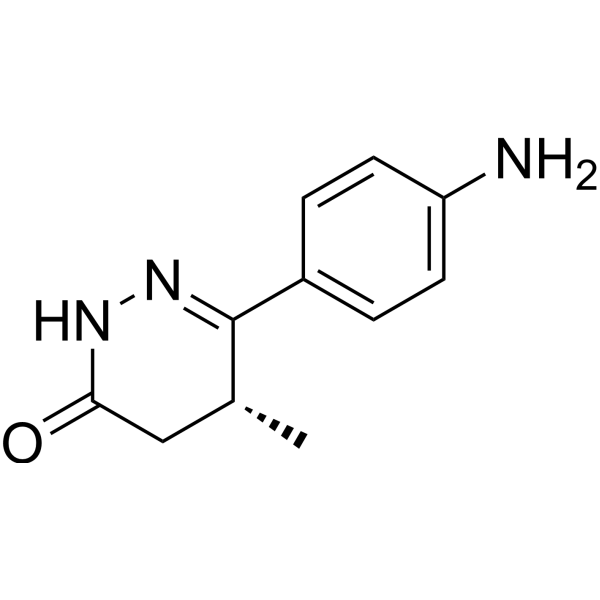
-
- HY-111098
-
|
|
TRP Channel
|
Cardiovascular Disease
|
|
GSK1702934A is a selective TRPC3 agonist. GSK1702934A modulates cardiac contractility and f arrhythmogenesis by activation of TRPC3 .
|
-

-
- HY-103296
-
-

-
- HY-N9141
-
|
|
5-HT Receptor
|
Neurological Disease
|
|
Nantenine is a serotonergic receptor antagonist. Nantenine selectively inhibits the contractile response of tissues to serotonin. Nantenine can be isolated from Nandina domestica .
|
-
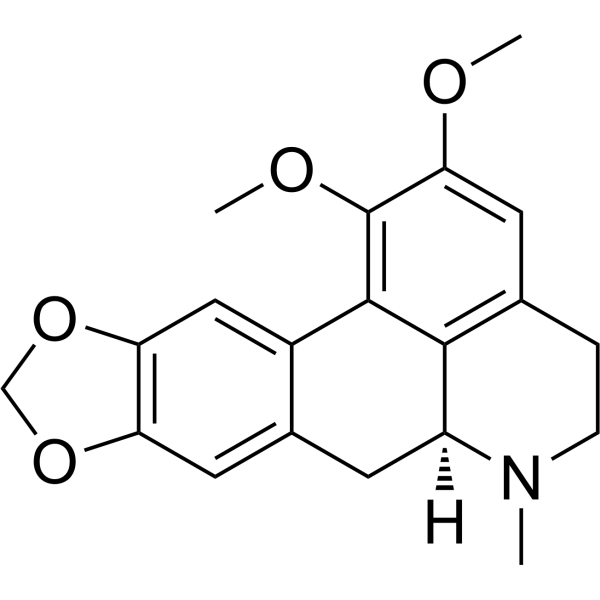
-
- HY-162345
-
|
|
Others
|
Cardiovascular Disease
|
|
CK-963 is an activator for cardiac troponin (cTnC) with Ki of 11.5 μM. CK-963 exhibits activity in enhancing cardiac contractility in Sprague-Dawley rats .
|
-

-
- HY-123268
-
|
|
Adrenergic Receptor
|
Cardiovascular Disease
|
|
Ro 363, an effective inotropic stimulant, is a potent and highly selective β1-adrenoceptor agonist. RO 363 is a cardiovascular modulator that reduces diastolic blood pressure and pronounces increases in myocardial contractility .
|
-

-
- HY-123268A
-
|
|
Adrenergic Receptor
|
Cardiovascular Disease
|
|
Ro 363 hydrochloride, an effective inotropic stimulant, is a potent and highly selective β1-adrenoceptor agonist. Ro 363 hydrochloride is a cardiovascular modulator that reduces diastolic blood pressure and pronounces increases in myocardial contractility .
|
-
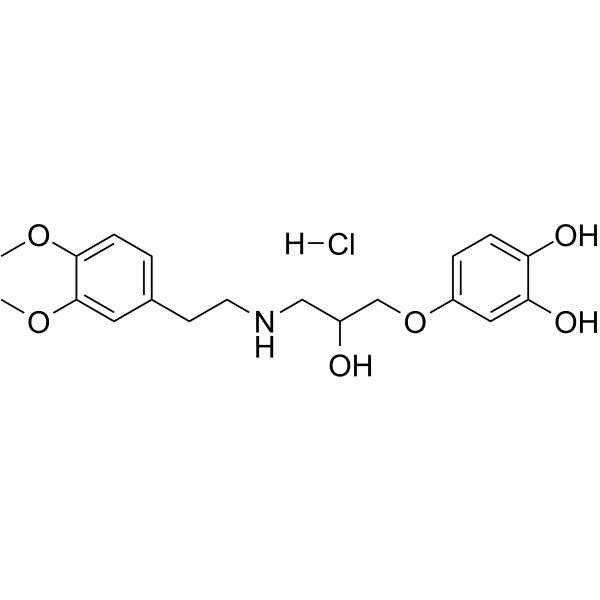
-
- HY-139801
-
|
CI-907
|
Angiotensin-converting Enzyme (ACE)
|
Metabolic Disease
|
|
Indolapril hydrochloride (CI-907) is an orally active nonsulfhydryl angiotensin converting enzyme (ACE) inhibitor. Indolapril hydrochloride is highly specific in suppressing the contractile or pressor responses to Angiotensin I. Indolapril hydrochloride is a potent antihypertensive agent .
|
-
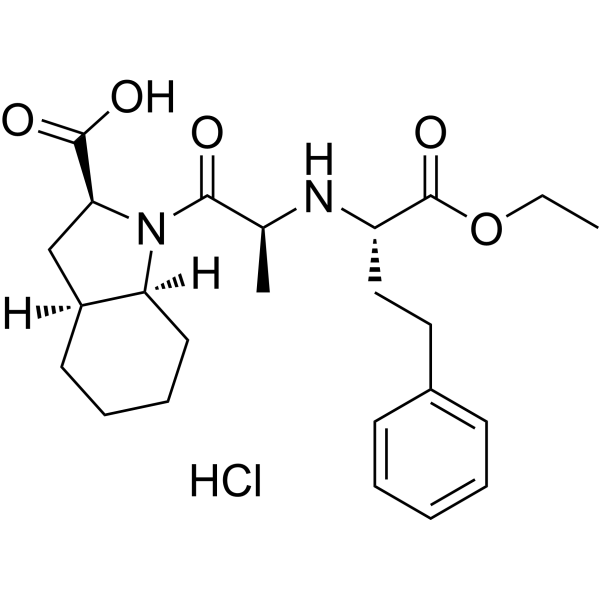
-
- HY-119926
-
|
Hydroxylupanine
|
Others
|
Cardiovascular Disease
Neurological Disease
|
|
13-Hydroxylupanine (Hydroxylupanine) is the typical alkaloid profile of sweet lupins.13-Hydroxylupanine blocks ganglionic transmission, decreases cardiac contractility and contracts uterine smooth muscle .
|
-
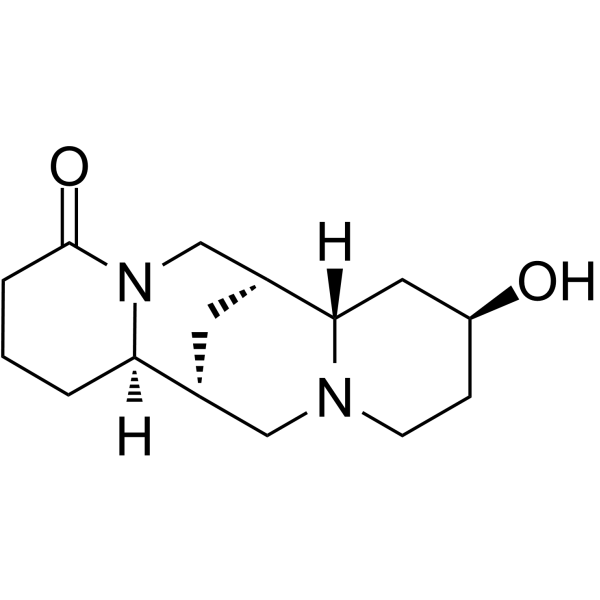
-
- HY-106844A
-
|
|
Others
|
Cardiovascular Disease
|
|
(+)-EMD 57033 is a cardiac troponin C (cTnC) activator, is a dominant Ca 2+ sensitizer. (+)-EMD 57033 binds the cardiac/slow skeletal troponin C isoform and exerts myocardial contractile promotion function .
|
-
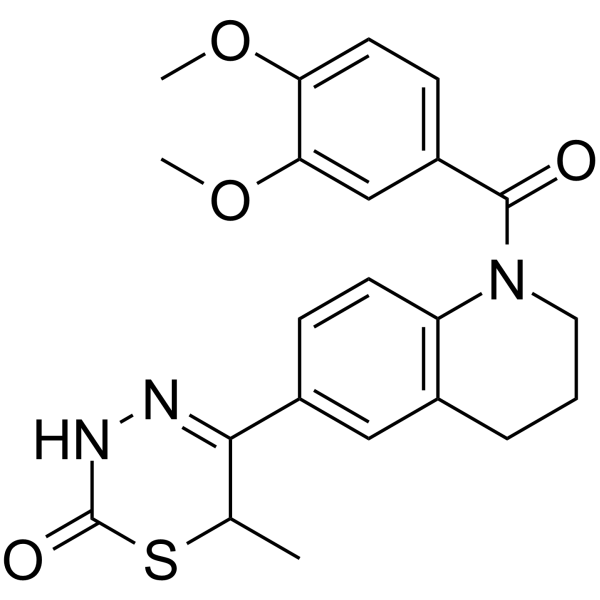
-
- HY-120648
-
|
|
Cytochrome P450
|
Cardiovascular Disease
|
|
CAY 10434 is a potent CYP4A hydroxylase inhibitor. CAY 10434 improves contractile response to angiotensin II with the maximal contractile response (Emax) 6764 mg .
|
-
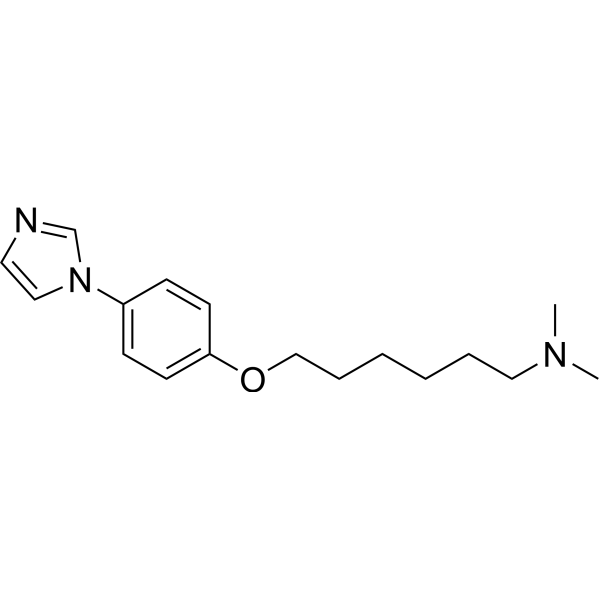
-
- HY-120648A
-
|
|
Cytochrome P450
|
Cardiovascular Disease
|
|
CAY 10434 dihydrochloride is a potent CYP4A hydroxylase inhibitor. CAY 10434 dihydrochloride improves contractile response to angiotensin II with the maximal contractile response (Emax) 6764 mg .
|
-
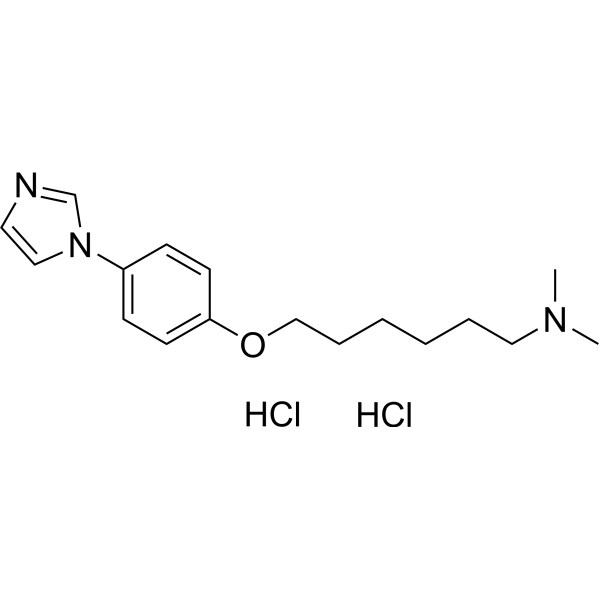
-
- HY-106577
-
|
Cifenline; Ro 22-7796
|
Potassium Channel
|
Cardiovascular Disease
|
|
Cibenzoline is a potent inhibitor of KATP channel with directly affecting the pore-forming Kir6.2 subunit rather than the SUR1 subunit. Cibenzoline is a class Ia antiarrhythmic agent. Cibenzoline has little anticholinergic activity. Cibenzoline markedly attenuate LVPG which has a close relationship with myocardial contractility decreasing. Cibenzoline has the potential for the research of hypertrophic obstructive cardiomyopathy .
|
-
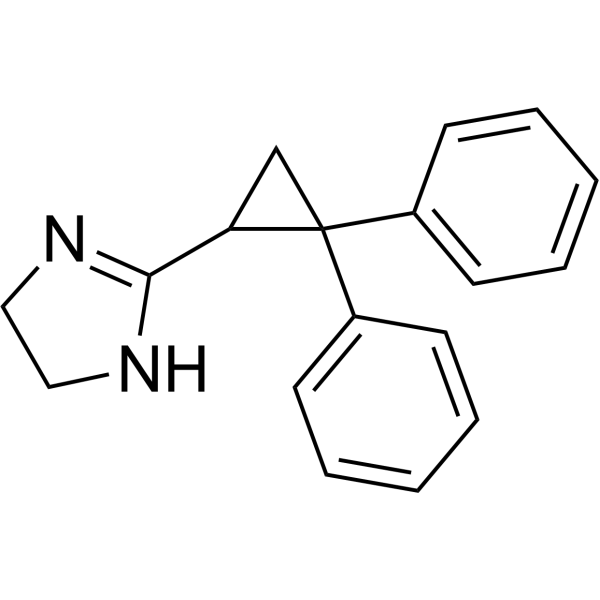
-
- HY-107645
-
|
|
mAChR
|
Neurological Disease
|
|
DAU 5884 hydrochloride is a potent muscarinic M3 receptor antagonist. DAU 5884 hydrochloride inhibits methacholine-dependent effects on cell proliferation and muscle contractility .
|
-
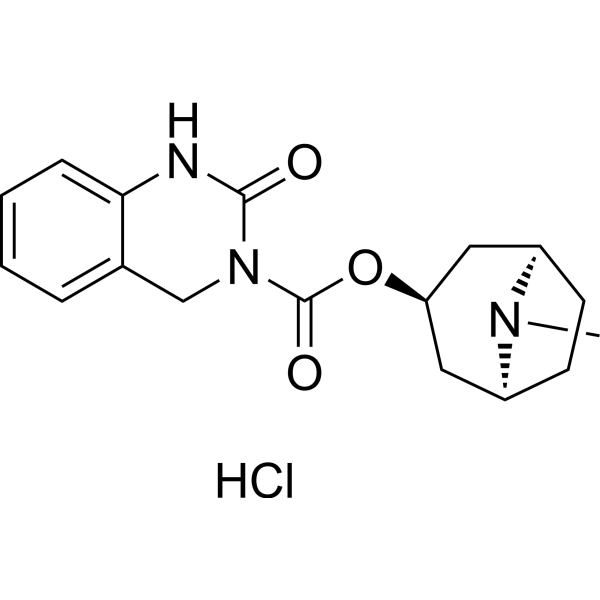
-
- HY-121306
-
|
Ricainide
|
Others
|
Neurological Disease
|
|
Indecainide (Ricainide) is an orally active antiarrhythmic agent. Indecainide can be used in the research of ventricular dysfunction .
|
-
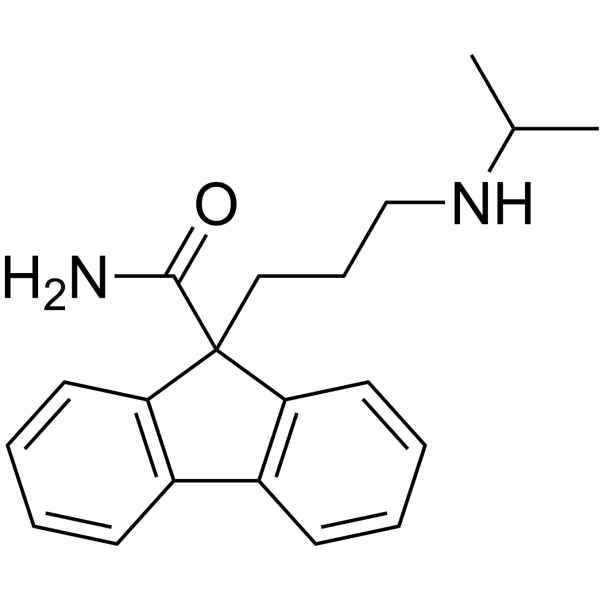
-
- HY-160076
-
|
|
Apelin Receptor (APJ)
|
Cardiovascular Disease
|
|
APJ receptor agonist 8 (compound 99) is an agonist of APJ receptor. APJ receptor agonist 8 increases the load independent cardiac contractility of isolated perfused rat hearts .
|
-
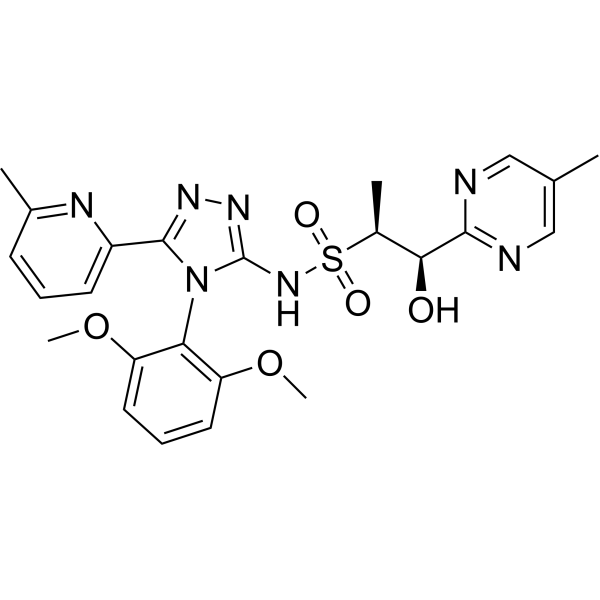
-
- HY-W008820
-
|
|
Endogenous Metabolite
|
Metabolic Disease
|
|
Glutaric acid, C5 dicarboxylic acid, is an intermediate during the catabolic pathways of lysine and tryptophan. Glutaric acid affects pericyte contractility and migration. Glutaric acid is an indicator of glutaric aciduria type I .
|
-
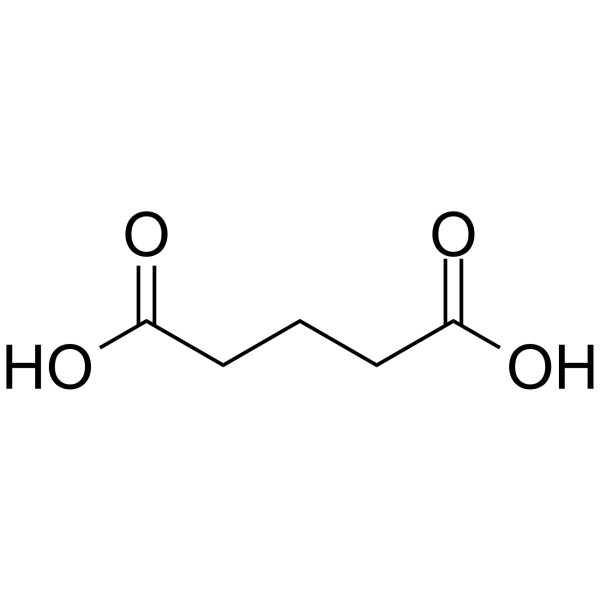
-
- HY-119926A
-
|
Hydroxylupanine hydrochloride
|
Others
|
Cardiovascular Disease
Neurological Disease
|
|
13-Hydroxylupanine Hydroxylupanine is the typical alkaloid profile of sweet lupins. 13-Hydroxylupanine Hydroxylupanine blocks ganglionic transmission, decreases cardiac contractility and contracts uterine smooth muscle .
|
-
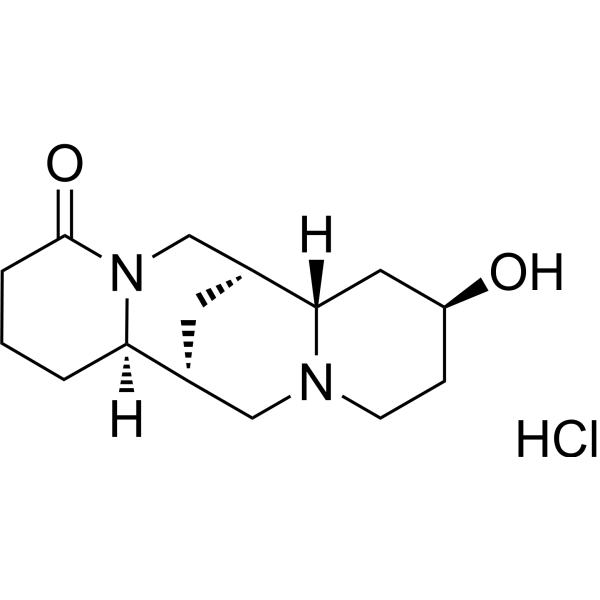
-
- HY-112071
-
|
|
Adrenergic Receptor
|
Cardiovascular Disease
|
|
Prenalterol is a selective β1-adrenergic receptor agonist. Prenalterol has no effect on gut smooth muscle contractile activity. Prenalterol can be used for researching cardiovascular disease .
|
-

-
- HY-108991
-
|
(-)-T-0509
|
Adrenergic Receptor
|
Cardiovascular Disease
|
|
T-0509 ((-)-T-0509) is a selective full agonist of the β1 receptor. T-0509 activates the cAMP signaling pathway through the β1 receptor and enhances myocardial contractility .
|
-
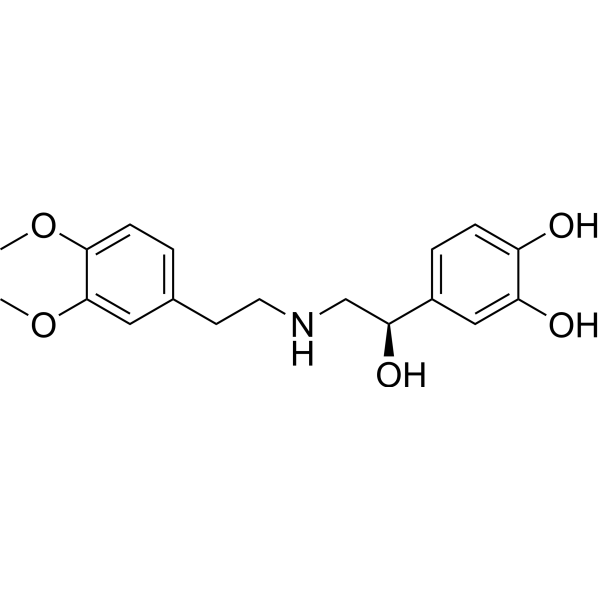
-
- HY-W008820S
-
|
|
Endogenous Metabolite
|
Metabolic Disease
|
|
Glutaric acid-d6 is the deuterium labeled Glutaric acid. Glutaric acid is an intermediate during the catabolic pathways of lysine and tryptophan. Glutaric acid affects pericyte contractility and migration. Glutaric acid is an indicator of glutaric aciduria type I[1][2][3].
|
-
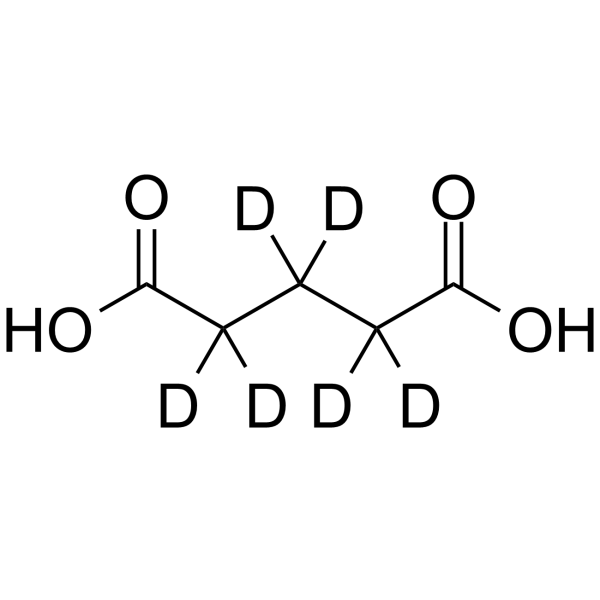
-
- HY-113096
-
|
PGD1
|
Endogenous Metabolite
|
Metabolic Disease
|
|
Prostaglandin D1 is a prostanoid which causes contractile and relaxant on isolated human pial arteries, it is also an inhibitor of ADP-induced platelet aggregation with an IC50 value of 320 ng/ml. Prostaglandin D1 can be used for metabolic research .
|
-

-
- HY-P4678
-
|
|
Vasopressin Receptor
|
Neurological Disease
|
|
(Phe2,Orn8)-Oxytocin is a selective V1 vasopressin agonist. (Phe2,Orn8)-Oxytocin induces a sustained contractility of rabbit epididymis with EC50 value of 280 nM .
|
-
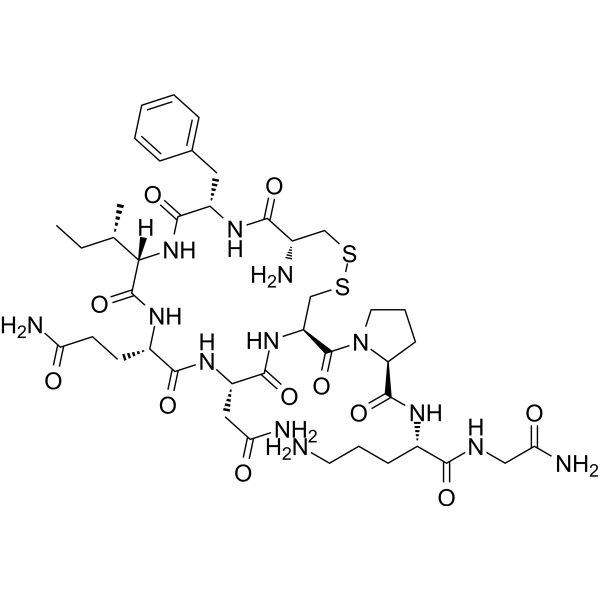
-
- HY-P4678A
-
|
|
Vasopressin Receptor
|
Neurological Disease
|
|
(Phe2,Orn8)-Oxytocin acetate is a selective V1 vasopressin agonist. (Phe2,Orn8)-Oxytocin acetate induces a sustained contractility of rabbit epididymis with EC50 value of 280 nM .
|
-
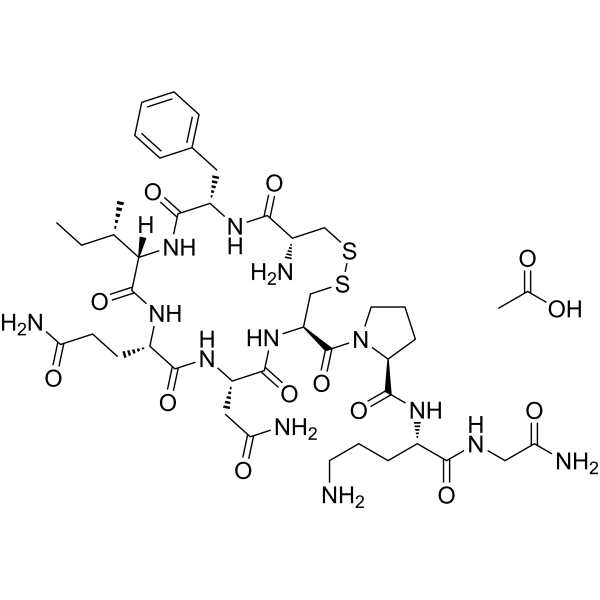
-
- HY-137574
-
|
19(R)-Hydroxy PGE1
|
Prostaglandin Receptor
|
Others
|
|
19(R)-Hydroxy prostaglandin E1 (19(R)-Hydroxy PGE1), the major prostaglandin in primate semen, is an agonist of EP1 and EP3 receptor subtypes and exhibits contractile activity on smooth muscle preparations .
|
-
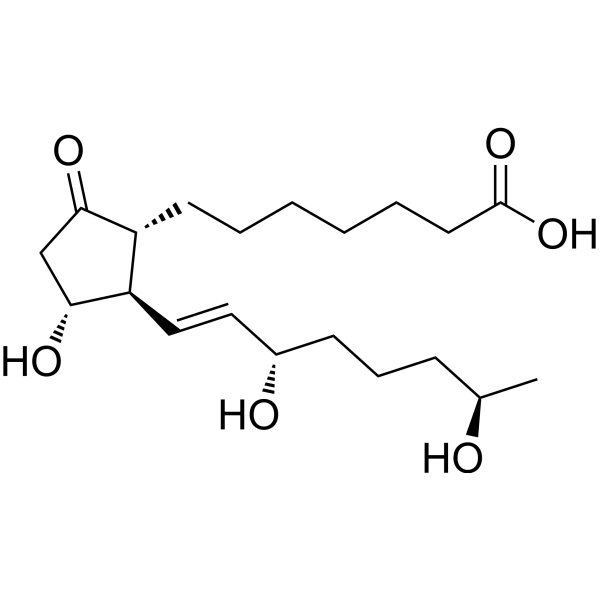
-
- HY-P3853
-
|
|
Neurokinin Receptor
|
Neurological Disease
|
|
GR 87389 is a potent NK2 receptor antagonist. GR 87389 antagonized GA 64349-induced smooth muscle strips contractions in a competitive manner in the human detrusor, prostate and prostatic urethra .
|
-
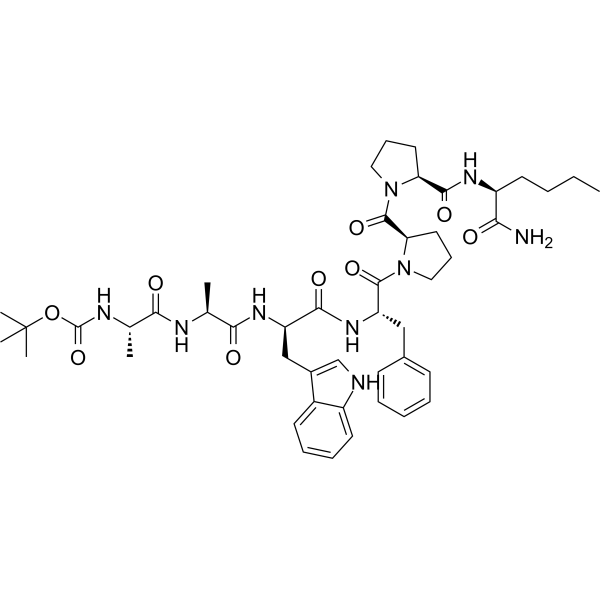
-
- HY-W008820S1
-
|
|
Endogenous Metabolite
|
Metabolic Disease
|
|
Glutaric acid-d4 is the deuterium labeled Glutaric acid. Glutaric acid, C5 dicarboxylic acid, is an intermediate during the catabolic pathways of lysine and tryptophan. Glutaric acid affects pericyte contractility and migration. Glutaric acid is an indicator of glutaric aciduria type I[1][2][3].
|
-
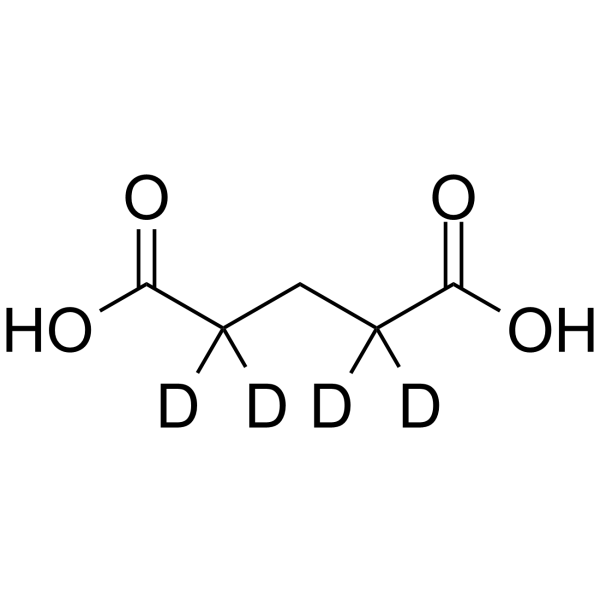
-
- HY-W008820S2
-
|
|
Endogenous Metabolite
|
Metabolic Disease
|
|
Glutaric acid-d2 is the deuterium labeled Glutaric acid. Glutaric acid, C5 dicarboxylic acid, is an intermediate during the catabolic pathways of lysine and tryptophan. Glutaric acid affects pericyte contractility and migration. Glutaric acid is an indicator of glutaric aciduria type I[1][2][3].
|
-

-
- HY-153977
-
|
|
NADPH Oxidase
|
Cardiovascular Disease
|
|
GLX481304 is a specific inhibitor of Nox-2 and -4, with IC50s of 1.25 μM. GLX481304 suppresses ROS production in isolated mouse cardiomyocytes and improves cardiomyocyte contractility. GLX481304 can be used for research of ischemic injury to the heart .
|
-
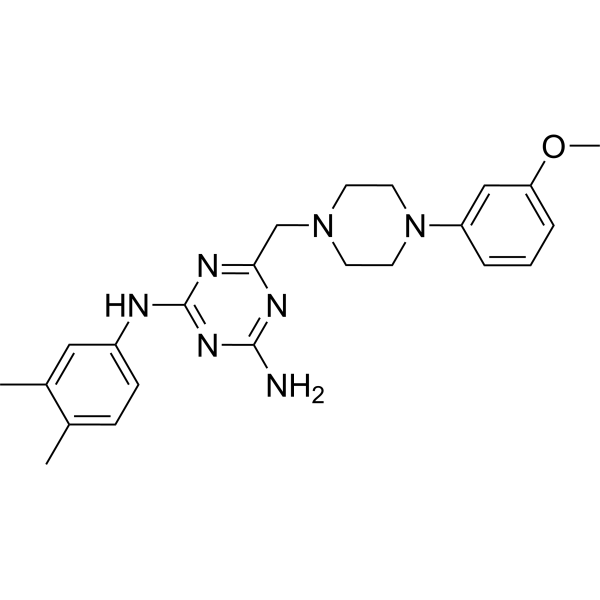
-
- HY-121467A
-
|
Z-338; YM443
|
Cholinesterase (ChE)
|
Others
Metabolic Disease
Inflammation/Immunology
|
|
Acotiamide hydrochloride is an orally active, selective and reversible acetylcholinesterase (AChE) inhibitor, with an IC50 of 1.79 μM. Acotiamide hydrochloride can enhance gastric contractility and accelerate delayed gastric emptying. Acotiamide hydrochloride has the potential for the research of functional dyspepsia involving gastric motility dysfunction and intestinal inflammatory .
|
-
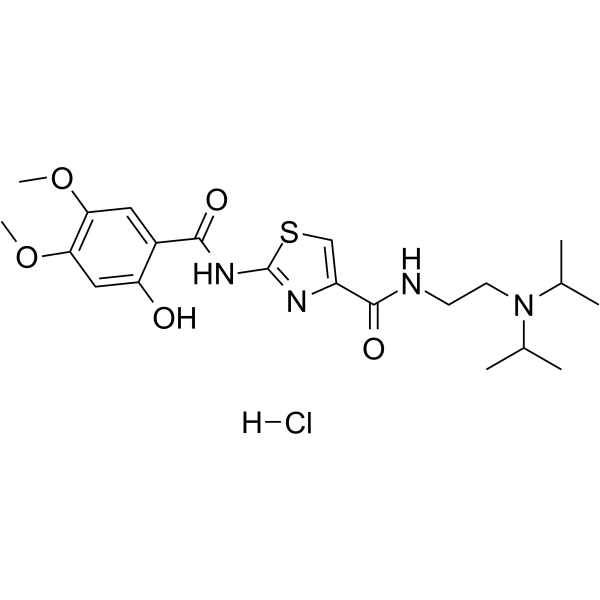
-
- HY-121467
-
|
Z-338 free base; YM443 free base
|
Cholinesterase (ChE)
|
Metabolic Disease
Inflammation/Immunology
|
|
Acotiamide is an orally active, selective and reversible acetylcholinesterase (AChE) inhibitor, with an IC50 of 1.79 μM. Acotiamide can enhance gastric contractility and accelerate delayed gastric emptying. Acotiamide has the potential for the research of functional dyspepsia involving gastric motility dysfunction and intestinal inflammatory .
|
-
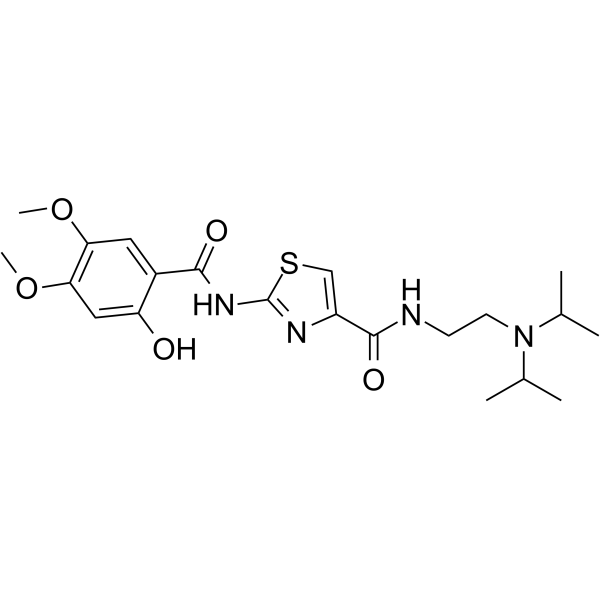
-
- HY-103283
-
|
GRP(18-27) (porcine)
|
Biochemical Assay Reagents
|
Neurological Disease
|
|
Neuromedin C porcine (GRP, 18-27, porcine) is a bombesin-like neuropeptide that can be obtained from porcine spinal cord. Neuromedin C porcine exhibits a potent contractile activity on rat uterus in the characteristic manner of bombesin. Neuromedin C porcine has research potential for neurological-related diseases .
|
-
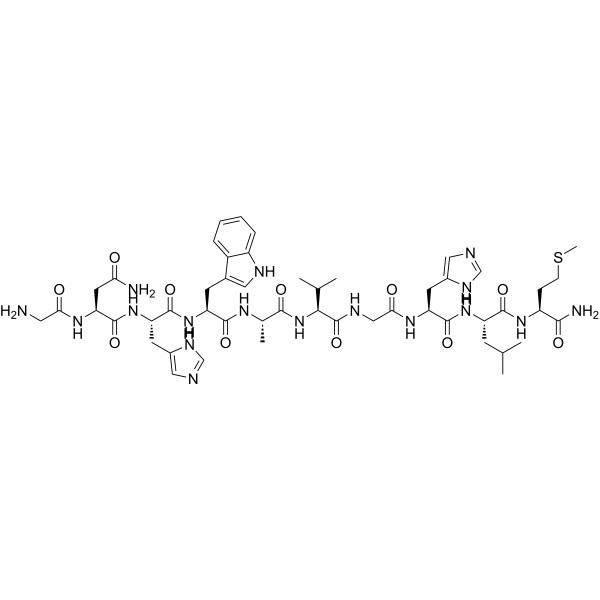
-
- HY-P3618
-
|
|
Somatostatin Receptor
|
Neurological Disease
|
|
Cortistatin 29 is a neuropeptide. Cortistatin 29 alleviates neuropathic pain. Cortistatin 29 binds with high affinity all somatostatin (SS) receptor subtypes and shows IC50 values of 2.8, 7.1, 0.2, 3.0, 13.7 nM for SSTR1, SSTR2, SSTR3, SSTR4, SSTR5, respectively. Cortistatin 29 shows anti-fibrotic effects .
|
-
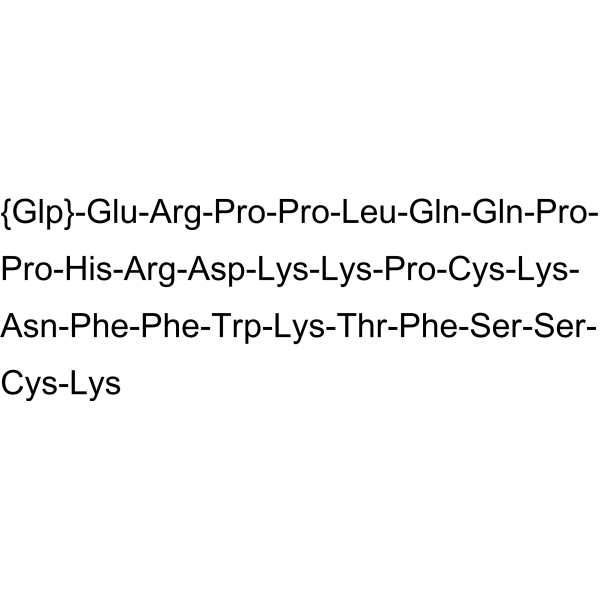
-
- HY-B2155
-
|
|
|
|
|
Acotiamide monohydrochloride trihydrate is an orally active, selective and reversible acetylcholinesterase (AChE) inhibitor, with IC50 of 1.79 μM. Acotiamide monohydrochloride trihydrate can enhance gastric contractility and accelerate delayed gastric emptying. Acotiamide monohydrochloride trihydrate has the potential for the research of functional dyspepsia involving gastric motility dysfunction and intestinal inflammatory .
|
-

-
- HY-P1428A
-
|
|
Neuropeptide Y Receptor
|
|
|
RFRP-1(human) TFA is a potent endogenous NPFF receptor agonist (EC50 values are 0.0011 and 29 nM for NPFF2 and NPFF1, respectively). Attenuates contractile function of isolated rat and rabbit cardiac myocytes. Reduces heart rate, stroke volume, ejection fraction and cardiac output, and increases plasma prolactin levels in rats.
|
-
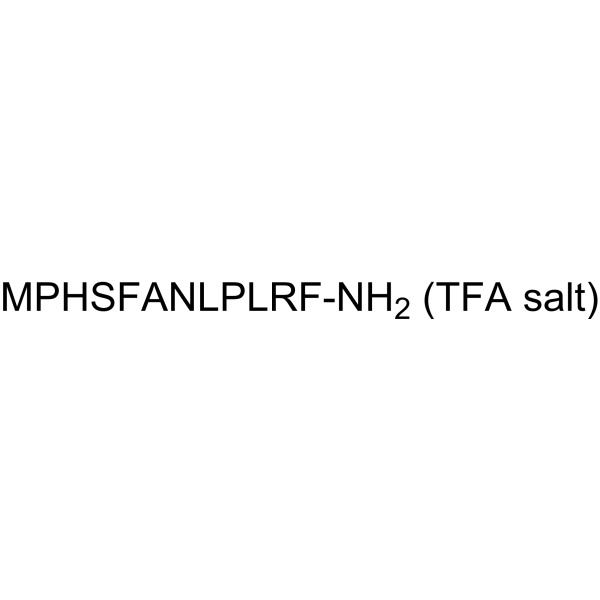
-
- HY-B0763
-
|
KC-404; AV-411; MN-166
|
Phosphodiesterase (PDE)
|
Inflammation/Immunology
Cancer
|
|
Ibudilast (KC-404; AV-411; MN-166) is a cyclic AMP phosphodiesterase (PDE) inhibitor. Ibudilast has platelet anti-aggregatory effects. Ibudilast can be used for the research of asthma for its inhibitory effects on tracheal smooth muscle contractility. Ibudilast may be a useful neuroprotective and anti-dementia agent counteracting neurotoxicity in activated microglia .
|
-
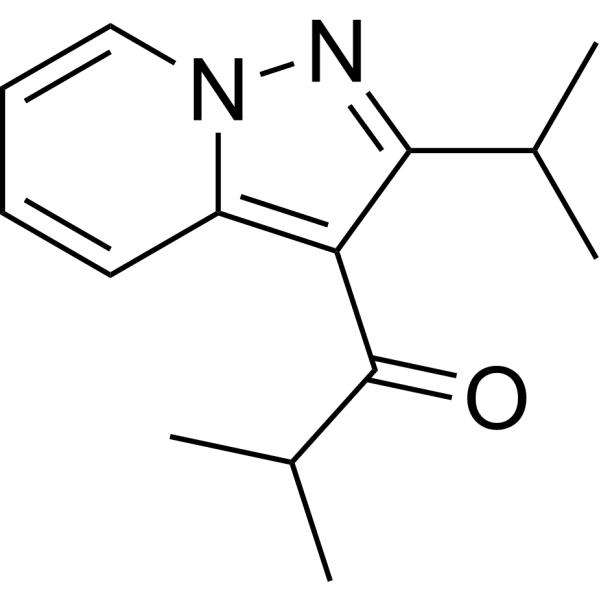
-
- HY-103209
-
|
|
Adrenergic Receptor
|
Cardiovascular Disease
Endocrinology
|
|
Rec 15/2615 hydrochloride is a potent and selective α-1B adrenoceptor antagonist with Ki values of 1.9 nM, 0.3 nM, 2.6 nM for α1A, α1B, α1D, respectively. Rec 15/2615 hydrochloride modulates vaginal smooth muscle contractility and genital engorgement .
|
-
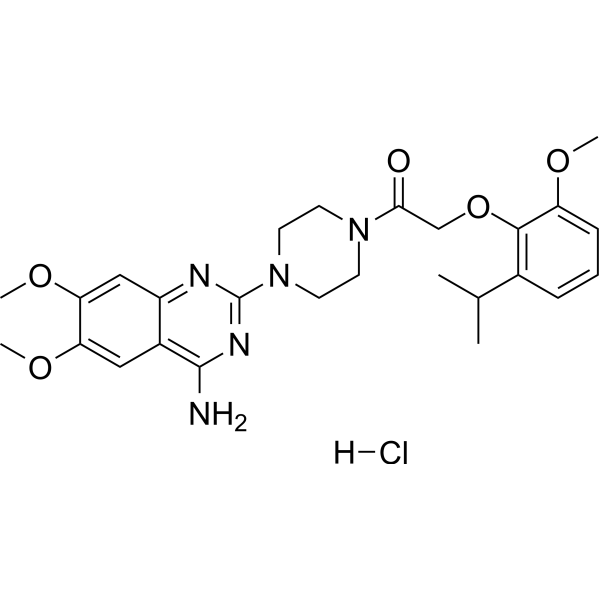
-
- HY-B1793
-
|
|
Potassium Channel
|
Neurological Disease
Cancer
|
|
Tetraethylammonium chloride is a non-selective potassium channel blocker. Tetraethylammonium chloride is a good substrate for organic cation transporter (OCTN1). Tetraethylammonium chloride antitumor properties .
|
-
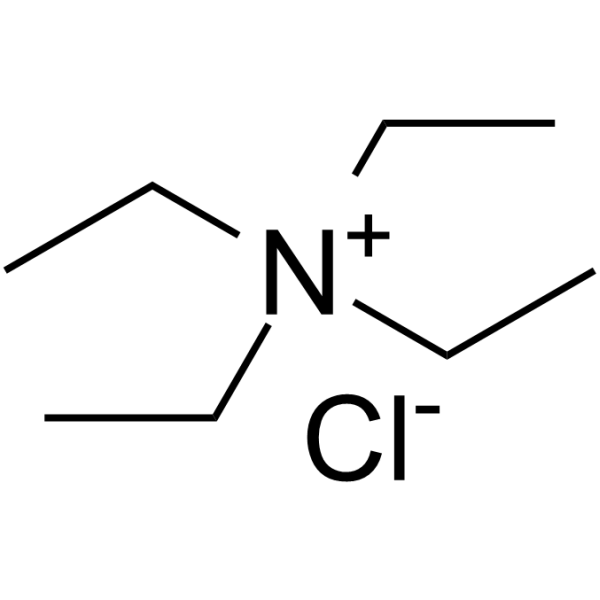
-
- HY-107610
-
|
|
Leukotriene Receptor
|
Inflammation/Immunology
|
|
SR2640 (hydrochloride) is a potent and selective competitive leukotriene D4/leukotriene E4 antagonist. SR2640 can be used for researching the role of leukotrienes in human asthma .
|
-
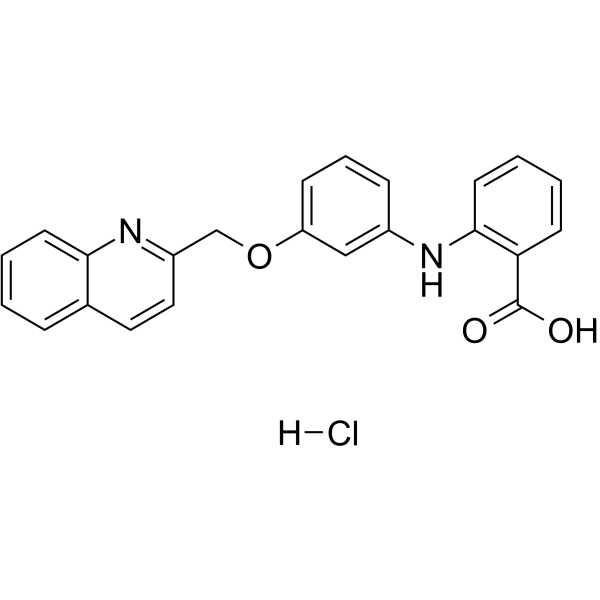
-
- HY-16056
-
|
|
Adrenergic Receptor
|
Cardiovascular Disease
|
|
Arbutamine is a short-acting, potent and nonselective β-adrenoceptor agonist. Arbutamine stimulates cardiac β1-, tracheal β2-, and adiopocyte β3- adrenergic receptors. Arbutamine provides cardiac stress increases heart rate, cardiac contractility, and systolic blood pressure. Arbutamine can be used for cardiac stress agent .
|
-
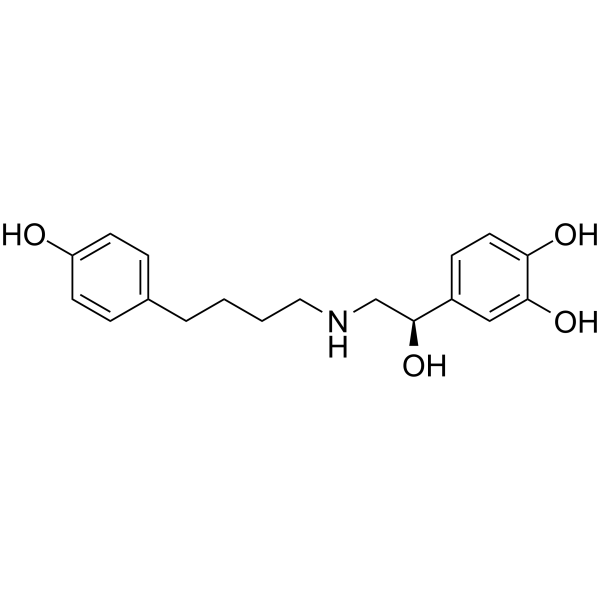
-
- HY-16056A
-
|
|
Adrenergic Receptor
|
Cardiovascular Disease
|
|
Arbutamine hydrochloride is a short-acting, potent and nonselective β-adrenoceptor agonist. Arbutamine hydrochloride stimulates cardiac β1-, tracheal β2-, and adiopocyte β3- adrenergic receptors. Arbutamine hydrochloride provides cardiac stress increases heart rate, cardiac contractility, and systolic blood pressure. Arbutamine hydrochloride can be used for cardiac stress agent .
|
-

-
- HY-115381
-
|
|
Endogenous Metabolite
|
Cardiovascular Disease
|
|
Lipoxin A5 is an eicosapentaenoic acid derived from pig white blood cells. Lipoxin A5 slowly contracted the guinea pig lung parenchymal strips with a contractile force similar to that of LXA4 and LXB4.2, but LXA5 did not have the vasodilating effect on the aortic smooth muscle shown by LXA4 and LXB4.2 .
|
-
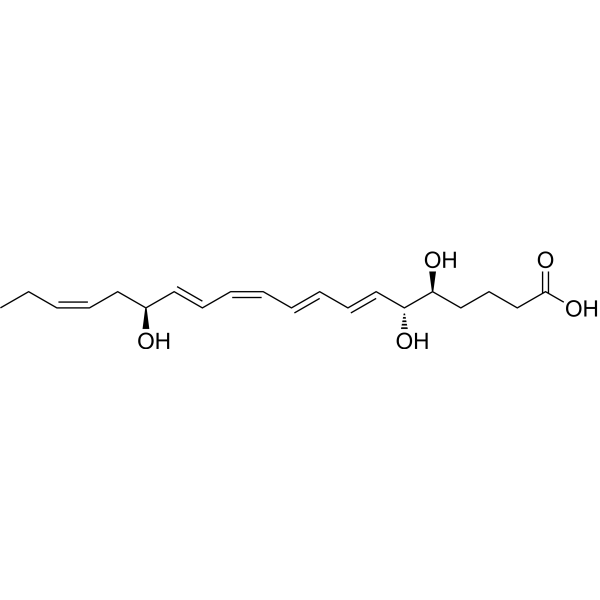
-
- HY-118960
-
|
|
ATP Synthase
|
Cardiovascular Disease
|
|
BMS-199264 hydrochloride is an inhibitor of F1F0 ATP hydrolase (IC50=0.5 μM) without inhibitory effect on F1F0 ATP synthase. BMS-199264 hydrochloride selectively inhibits ATP decline during ischemia to reduces cardiac necrosis. BMS-199264 hydrochloride also enhances the recovery of contractile function following reperfusion .
|
-
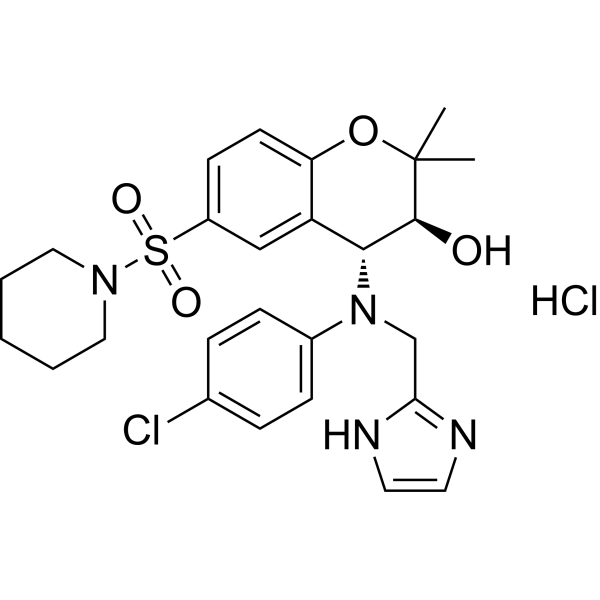
-
- HY-103291
-
|
|
Bradykinin Receptor
|
Inflammation/Immunology
Endocrinology
|
|
Sar-[D-Phe8]-des-Arg9-Bradykinin is a agonist of B1 receptor. Sar-[D-Phe8]-des-Arg9-Bradykinin selectively amplifies the contractile response when incubation with human recombinant interleukin-1 β (IL-1 β) in rabbit aortic rings .
|
-
![Sar-[D-Phe8]-des-Arg9-Bradykinin](//file.medchemexpress.com/product_pic/hy-103291.gif)
-
- HY-B0763S1
-
|
|
Isotope-Labeled Compounds
Phosphodiesterase (PDE)
|
Inflammation/Immunology
Cancer
|
|
Ibudilast-d7 is the deuterium labeled Ibudilast. Ibudilast (KC-404; AV-411; MN-166) is a cyclic AMP phosphodiesterase (PDE) inhibitor. Ibudilast has platelet anti-aggregatory effects. Ibudilast can be used for the research of asthma for its inhibitory effects on tracheal smooth muscle contractility. Ibudilast may be a useful neuroprotective and anti-dementia agent counteracting neurotoxicity in activated microglia[1].
|
-
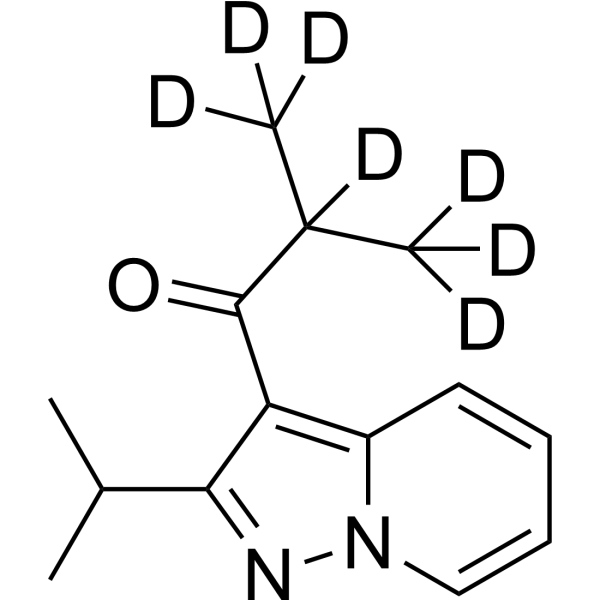
-
- HY-150039
-
|
|
G Protein-coupled Receptor Kinase (GRK)
|
Cardiovascular Disease
|
|
CCG-271423 is a potent and selective GRK5 inhibitor with IC50 values of 0.0021 μM and 44 μM for GRK5 and GRK2, respectively. CCG-271423 inhibits cardiomyocyte contractility and decreases in Ca 2+ transience . CCG-271423 is a click chemistry reagent, it contains an Alkyne group and can undergo copper-catalyzed azide-alkyne cycloaddition (CuAAc) with molecules containing Azide groups.
|
-

-
- HY-B0763S2
-
|
KC-404-d7-1; AV-411-d7-1; MN-166-d7-1
|
Phosphodiesterase (PDE)
|
|
|
Ibudilast-d7-1 is the deuterium labeled Ibudilast[1]. Ibudilast (KC-404;AV-411;MN-166) is a cyclic AMP phosphodiesterase (PDE) inhibitor. Ibudilast has platelet anti-aggregatory effects. Ibudilast can be used for the research of asthma for its inhibitory effects on tracheal smooth muscle contractility. Ibudilast may be a useful neuroprotective and anti-dementia agent counteracting neurotoxicity in activated microglia[2].
|
-

-
- HY-P4160
-
|
THG113.31; ILGHXDYK
|
Prostaglandin Receptor
|
Endocrinology
|
|
PDC31 (THG113.31; ILGHXDYK) is an allosteric and non-competitive inhibitor of FP Prostaglandin Receptor. PDC31 is the D-amino acid-based oligopeptide, is used for smooth muscle contractile agent. PDC31 decreases the strength and duration of uterine contractions in vivo, which can be used for research of preterm labor and primary dysmenorrhea (PD). PDC31 also enhances Ca 2+-dependent large-conductance K +-channel in human myometrial cells .
|
-
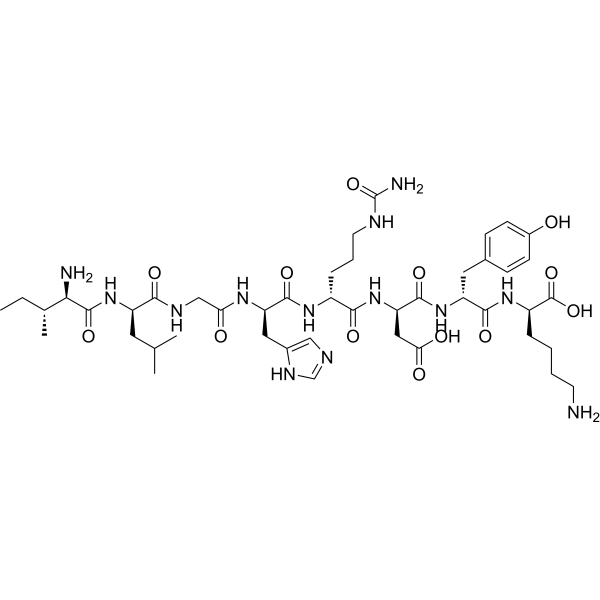
-
- HY-P2141A
-
|
|
Angiotensin Receptor
Arrestin
|
Cardiovascular Disease
|
|
TRV120027 TFA, a β-arrestin-1-biased agonist of the angiotensin II receptor type 1 (AT1R), engages ß-arrestins while blocking G-protein signaling . TRV120027 TFA induces acute catecholamine secretion through cation channel subfamily C3 (TRPC3) coupling, promotes the formation of a macromolecular complex composed of AT1R–β-arrestin-1–TRPC3–PLCγ at the plasma membrane. TRV120027 TFA inhibits angiotensin II–mediated vasoconstriction and increases cardiomyocyte contractility. TRV120027 TFA has the potential for the acute decompensated heart failure (ADHF) treatment .
|
-

-
- HY-P2141
-
|
|
Angiotensin Receptor
Arrestin
|
Cardiovascular Disease
|
|
TRV120027, a β-arrestin-1-biased agonist of the angiotensin II receptor type 1 (AT1R), engages ß-arrestins while blocking G-protein signaling . TRV120027 induces acute catecholamine secretion through cation channel subfamily C3 (TRPC3) coupling, promotes the formation of a macromolecular complex composed of AT1R–β-arrestin-1–TRPC3–PLCγ at the plasma membrane. TRV120027 inhibits angiotensin II–mediated vasoconstriction and increases cardiomyocyte contractility. TRV120027 has the potential for the acute decompensated heart failure (ADHF) treatment .
|
-

| Cat. No. |
Product Name |
Target |
Research Area |
-
- HY-P3591
-
-
- HY-P4678
-
|
|
Vasopressin Receptor
|
Neurological Disease
|
|
(Phe2,Orn8)-Oxytocin is a selective V1 vasopressin agonist. (Phe2,Orn8)-Oxytocin induces a sustained contractility of rabbit epididymis with EC50 value of 280 nM .
|
-
- HY-P4678A
-
|
|
Vasopressin Receptor
|
Neurological Disease
|
|
(Phe2,Orn8)-Oxytocin acetate is a selective V1 vasopressin agonist. (Phe2,Orn8)-Oxytocin acetate induces a sustained contractility of rabbit epididymis with EC50 value of 280 nM .
|
-
- HY-P3853
-
|
|
Neurokinin Receptor
|
Neurological Disease
|
|
GR 87389 is a potent NK2 receptor antagonist. GR 87389 antagonized GA 64349-induced smooth muscle strips contractions in a competitive manner in the human detrusor, prostate and prostatic urethra .
|
-
- HY-103283
-
|
GRP(18-27) (porcine)
|
Biochemical Assay Reagents
|
Neurological Disease
|
|
Neuromedin C porcine (GRP, 18-27, porcine) is a bombesin-like neuropeptide that can be obtained from porcine spinal cord. Neuromedin C porcine exhibits a potent contractile activity on rat uterus in the characteristic manner of bombesin. Neuromedin C porcine has research potential for neurological-related diseases .
|
-
- HY-P3618
-
|
|
Somatostatin Receptor
|
Neurological Disease
|
|
Cortistatin 29 is a neuropeptide. Cortistatin 29 alleviates neuropathic pain. Cortistatin 29 binds with high affinity all somatostatin (SS) receptor subtypes and shows IC50 values of 2.8, 7.1, 0.2, 3.0, 13.7 nM for SSTR1, SSTR2, SSTR3, SSTR4, SSTR5, respectively. Cortistatin 29 shows anti-fibrotic effects .
|
-
- HY-P1428A
-
|
|
Neuropeptide Y Receptor
|
|
|
RFRP-1(human) TFA is a potent endogenous NPFF receptor agonist (EC50 values are 0.0011 and 29 nM for NPFF2 and NPFF1, respectively). Attenuates contractile function of isolated rat and rabbit cardiac myocytes. Reduces heart rate, stroke volume, ejection fraction and cardiac output, and increases plasma prolactin levels in rats.
|
-
- HY-103291
-
|
|
Bradykinin Receptor
|
Inflammation/Immunology
Endocrinology
|
|
Sar-[D-Phe8]-des-Arg9-Bradykinin is a agonist of B1 receptor. Sar-[D-Phe8]-des-Arg9-Bradykinin selectively amplifies the contractile response when incubation with human recombinant interleukin-1 β (IL-1 β) in rabbit aortic rings .
|
-
- HY-P0084
-
|
SRIF-14; Somatostatin-14
|
Peptides
|
Cardiovascular Disease
Neurological Disease
|
|
Cyclic somatostatin (SRIF-14) is a growth hormone-release inhibiting factor used in the research of severe, acute hemorrhages of gastroduodenal ulcers. Cyclic somatostatin is a neuropeptide co-stored with acetylcholine in the cardiac parasympathetic innervation, exerts influences directly on contraction of ventricular cardiomyocytes. Cyclic somatostatin inhibits the contractile response of isoprenaline with an IC50 value of 13 nM. Cyclic somatostatin can be used for the research of cardiovascular disease .
|
-
- HY-P4160
-
|
THG113.31; ILGHXDYK
|
Prostaglandin Receptor
|
Endocrinology
|
|
PDC31 (THG113.31; ILGHXDYK) is an allosteric and non-competitive inhibitor of FP Prostaglandin Receptor. PDC31 is the D-amino acid-based oligopeptide, is used for smooth muscle contractile agent. PDC31 decreases the strength and duration of uterine contractions in vivo, which can be used for research of preterm labor and primary dysmenorrhea (PD). PDC31 also enhances Ca 2+-dependent large-conductance K +-channel in human myometrial cells .
|
-
- HY-P2141A
-
|
|
Angiotensin Receptor
Arrestin
|
Cardiovascular Disease
|
|
TRV120027 TFA, a β-arrestin-1-biased agonist of the angiotensin II receptor type 1 (AT1R), engages ß-arrestins while blocking G-protein signaling . TRV120027 TFA induces acute catecholamine secretion through cation channel subfamily C3 (TRPC3) coupling, promotes the formation of a macromolecular complex composed of AT1R–β-arrestin-1–TRPC3–PLCγ at the plasma membrane. TRV120027 TFA inhibits angiotensin II–mediated vasoconstriction and increases cardiomyocyte contractility. TRV120027 TFA has the potential for the acute decompensated heart failure (ADHF) treatment .
|
-
- HY-P2141
-
|
|
Angiotensin Receptor
Arrestin
|
Cardiovascular Disease
|
|
TRV120027, a β-arrestin-1-biased agonist of the angiotensin II receptor type 1 (AT1R), engages ß-arrestins while blocking G-protein signaling . TRV120027 induces acute catecholamine secretion through cation channel subfamily C3 (TRPC3) coupling, promotes the formation of a macromolecular complex composed of AT1R–β-arrestin-1–TRPC3–PLCγ at the plasma membrane. TRV120027 inhibits angiotensin II–mediated vasoconstriction and increases cardiomyocyte contractility. TRV120027 has the potential for the acute decompensated heart failure (ADHF) treatment .
|
| Cat. No. |
Product Name |
Category |
Target |
Chemical Structure |
| Cat. No. |
Product Name |
Chemical Structure |
-
- HY-W008820S
-
|
|
|
Glutaric acid-d6 is the deuterium labeled Glutaric acid. Glutaric acid is an intermediate during the catabolic pathways of lysine and tryptophan. Glutaric acid affects pericyte contractility and migration. Glutaric acid is an indicator of glutaric aciduria type I[1][2][3].
|
-

-
- HY-W008820S1
-
|
|
|
Glutaric acid-d4 is the deuterium labeled Glutaric acid. Glutaric acid, C5 dicarboxylic acid, is an intermediate during the catabolic pathways of lysine and tryptophan. Glutaric acid affects pericyte contractility and migration. Glutaric acid is an indicator of glutaric aciduria type I[1][2][3].
|
-

-
- HY-W008820S2
-
|
|
|
Glutaric acid-d2 is the deuterium labeled Glutaric acid. Glutaric acid, C5 dicarboxylic acid, is an intermediate during the catabolic pathways of lysine and tryptophan. Glutaric acid affects pericyte contractility and migration. Glutaric acid is an indicator of glutaric aciduria type I[1][2][3].
|
-

-
- HY-B0763S1
-
|
|
|
Ibudilast-d7 is the deuterium labeled Ibudilast. Ibudilast (KC-404; AV-411; MN-166) is a cyclic AMP phosphodiesterase (PDE) inhibitor. Ibudilast has platelet anti-aggregatory effects. Ibudilast can be used for the research of asthma for its inhibitory effects on tracheal smooth muscle contractility. Ibudilast may be a useful neuroprotective and anti-dementia agent counteracting neurotoxicity in activated microglia[1].
|
-

-
- HY-B0763S2
-
|
|
|
Ibudilast-d7-1 is the deuterium labeled Ibudilast[1]. Ibudilast (KC-404;AV-411;MN-166) is a cyclic AMP phosphodiesterase (PDE) inhibitor. Ibudilast has platelet anti-aggregatory effects. Ibudilast can be used for the research of asthma for its inhibitory effects on tracheal smooth muscle contractility. Ibudilast may be a useful neuroprotective and anti-dementia agent counteracting neurotoxicity in activated microglia[2].
|
-

| Cat. No. |
Product Name |
|
Classification |
-
- HY-150039
-
|
|
|
Alkynes
|
|
CCG-271423 is a potent and selective GRK5 inhibitor with IC50 values of 0.0021 μM and 44 μM for GRK5 and GRK2, respectively. CCG-271423 inhibits cardiomyocyte contractility and decreases in Ca 2+ transience . CCG-271423 is a click chemistry reagent, it contains an Alkyne group and can undergo copper-catalyzed azide-alkyne cycloaddition (CuAAc) with molecules containing Azide groups.
|
Your information is safe with us. * Required Fields.
Inquiry Information
- Product Name:
- Cat. No.:
- Quantity:
- MCE Japan Authorized Agent:

















































![Sar-[D-Phe8]-des-Arg9-Bradykinin](http://file.medchemexpress.com/product_pic/hy-103291.gif)








